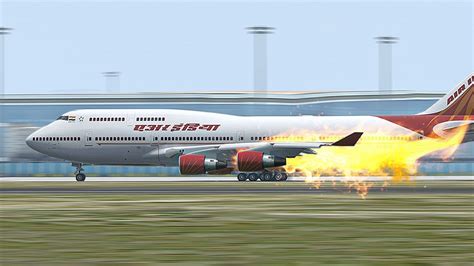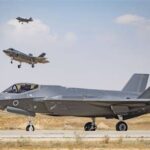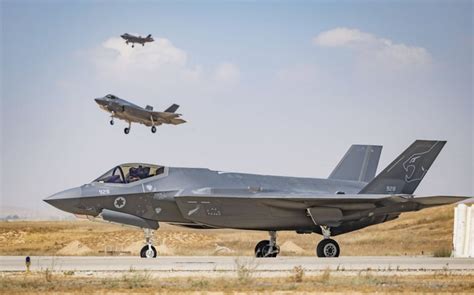
A harrowing video has emerged showing an Air India jet struggling to take off from a small airport in the remote Himalayan region of Ladakh, India, narrowly avoiding disaster as it clipped a perimeter wall. The incident, which occurred on April 25, involved an Airbus A320 attempting to depart from Kushok Bakula Rimpochee Airport in Leh, one of the world’s highest-altitude airports. The footage, now circulating widely, reveals the aircraft’s tail scraping against the wall before gaining altitude, prompting serious safety concerns and an ongoing investigation.
The video, initially shared on social media and subsequently picked up by news outlets, shows the Air India plane accelerating down the runway, its tail making contact with the airport’s perimeter wall just before liftoff. The visual evidence starkly illustrates the precarious nature of the takeoff and the potential for a catastrophic outcome. According to an Air India spokesperson quoted by NDTV, the flight, AI-445, was bound for Delhi and was carrying 131 passengers and crew members. Following the incident, the aircraft continued to Delhi, where it underwent a thorough inspection.
“On April 25, 2024, Air India flight AI445, operating from Leh to Delhi, made a safe landing in Delhi. During take-off from Leh, the aircraft’s tail made contact with the perimeter wall. The aircraft is currently undergoing necessary inspections,” the Air India spokesperson stated.
The incident has raised significant questions about the operational challenges at high-altitude airports, the decision-making process of the flight crew, and the standard operating procedures followed by Air India. The Directorate General of Civil Aviation (DGCA), India’s aviation regulatory body, has launched a formal investigation to determine the cause of the near-miss and to assess whether any safety protocols were violated. The investigation will scrutinize factors such as the aircraft’s weight, the runway length available for takeoff, weather conditions, and the crew’s adherence to established procedures.
Kushok Bakula Rimpochee Airport, situated at an altitude of 10,682 feet (3,256 meters), presents unique challenges for pilots. The thin air at such high altitudes reduces engine power and lift, requiring longer takeoff runs and precise calculations to ensure a safe departure. The airport’s relatively short runway further compounds these challenges, demanding meticulous planning and execution from flight crews.
The Air India incident is not the first time concerns have been raised about flight operations at Leh airport. In the past, aviation experts have highlighted the need for enhanced safety measures and infrastructure improvements to mitigate the risks associated with high-altitude takeoffs and landings. The recent near-miss underscores the importance of these concerns and the urgency of addressing them to prevent future accidents.
Detailed Account of the Incident
The Air India flight AI-445, an Airbus A320, was scheduled to depart from Leh for Delhi on the morning of April 25. Leh, the largest town in the Ladakh region, is a popular tourist destination, and the flight was carrying a full complement of passengers and crew. The weather conditions at the time of the takeoff were reportedly clear, with good visibility.
As the aircraft accelerated down the runway, it became apparent that the takeoff was not proceeding as smoothly as planned. Eyewitnesses reported that the plane appeared to be struggling to gain speed, and the angle of ascent seemed shallower than usual. The video footage confirms these observations, showing the aircraft’s tail section making contact with the perimeter wall just as it lifted off the ground.
The impact with the wall caused a visible jolt to the aircraft, but the pilots managed to maintain control and continue the takeoff. The plane climbed steadily, and the crew informed air traffic control about the incident. Despite the potential damage to the aircraft, the pilots decided to proceed to Delhi, where a more thorough inspection could be conducted.
Upon landing in Delhi, engineers examined the aircraft and discovered damage to the tail section. The extent of the damage has not been publicly disclosed, but it is believed to be significant enough to require repairs before the aircraft can be returned to service. The DGCA has impounded the aircraft as part of its investigation.
The Investigation
The DGCA’s investigation into the Air India incident is expected to be comprehensive and thorough. The investigation team will include aviation safety experts, flight operations specialists, and aircraft maintenance engineers. The team will examine all aspects of the flight, including the pre-flight planning, the takeoff procedure, and the condition of the aircraft.
One of the key areas of focus will be the aircraft’s weight and balance. High-altitude airports require careful weight management to compensate for the reduced engine power and lift. Investigators will determine whether the aircraft was within its permissible weight limits and whether the load was properly distributed.
The investigation will also examine the runway length available for takeoff. Leh airport has a relatively short runway, which can be challenging for larger aircraft. Investigators will assess whether the runway length was adequate for the Air India flight, considering the aircraft’s weight and the prevailing weather conditions.
The crew’s actions will also come under scrutiny. Investigators will review the flight data recorder (FDR) and the cockpit voice recorder (CVR) to analyze the pilots’ decision-making process and their adherence to standard operating procedures. The investigation will seek to determine whether the pilots made any errors that contributed to the incident.
In addition to these technical factors, the investigation will also consider the human element. Investigators will interview the pilots, the air traffic controllers, and other personnel involved in the flight to gather information about their experience and training. The investigation will seek to identify any systemic issues that may have contributed to the incident.
Challenges of High-Altitude Airports
Airports located at high altitudes pose unique challenges for aviation. The reduced air density at high altitudes affects aircraft performance in several ways.
- Reduced Engine Power: The engines produce less power at high altitudes because there is less oxygen available for combustion. This means that aircraft require longer takeoff runs and have a reduced rate of climb.
- Reduced Lift: The wings generate less lift at high altitudes because the air is thinner. This means that aircraft must fly at higher speeds to maintain altitude.
- Increased True Airspeed: The true airspeed (TAS) is the speed of the aircraft relative to the air. At high altitudes, the TAS is higher than the indicated airspeed (IAS) because the air is less dense. This means that pilots must be aware of the difference between TAS and IAS to avoid exceeding the aircraft’s limitations.
- Weight Restrictions: Aircraft operating at high-altitude airports often face weight restrictions to compensate for the reduced engine power and lift. This means that airlines may have to limit the number of passengers or cargo they carry.
In addition to these performance challenges, high-altitude airports also present operational challenges.
- Weather Conditions: High-altitude airports are often subject to adverse weather conditions, such as strong winds, snow, and ice. These conditions can make takeoff and landing more difficult and increase the risk of accidents.
- Navigation Challenges: The mountainous terrain around high-altitude airports can make navigation more challenging. Pilots must be familiar with the local terrain and use precise navigation techniques to avoid obstacles.
- Limited Infrastructure: Many high-altitude airports have limited infrastructure, such as short runways, inadequate lighting, and limited air traffic control facilities. This can make flight operations more difficult and increase the risk of accidents.
Past Incidents and Safety Recommendations
While major accidents are rare, there have been several incidents at high-altitude airports that highlight the risks associated with these operations. These incidents have led to recommendations for enhanced safety measures, including:
- Runway Extensions: Extending runways can provide aircraft with more room to accelerate and take off, reducing the risk of a tail strike or other incidents.
- Improved Lighting: Enhancing runway lighting can improve visibility during takeoff and landing, especially in adverse weather conditions.
- Enhanced Air Traffic Control: Upgrading air traffic control facilities can improve communication between pilots and controllers, reducing the risk of errors.
- Pilot Training: Providing pilots with specialized training for high-altitude operations can improve their ability to handle the challenges of these airports.
- Weight Management Programs: Implementing strict weight management programs can ensure that aircraft are within their permissible weight limits, reducing the risk of performance issues.
- Regular Inspections: Conducting regular inspections of aircraft and airport infrastructure can identify and address potential safety hazards before they lead to accidents.
Air India’s Response and Future Actions
Following the Leh incident, Air India has reiterated its commitment to safety and has pledged to cooperate fully with the DGCA’s investigation. The airline has also taken steps to review its operating procedures for high-altitude airports.
“Air India gives utmost priority to safety and has reported the incident to the regulatory authorities. We are cooperating with the investigation and will take appropriate action based on the findings,” the airline spokesperson stated.
Air India is also considering additional training for its pilots who operate flights to high-altitude airports. The training will focus on the unique challenges of these airports and the techniques for mitigating the risks.
In addition, Air India is working with airport authorities to improve the infrastructure at Leh airport. The airline is advocating for runway extensions, improved lighting, and enhanced air traffic control facilities.
Expert Opinions
Aviation experts have weighed in on the Air India incident, offering insights into the potential causes and the implications for future flight operations at high-altitude airports.
“High-altitude airports require a different level of skill and attention to detail,” said Captain Rajiv Sharma, a retired airline pilot with extensive experience flying to mountainous regions. “Pilots must be acutely aware of the aircraft’s performance limitations and make precise calculations to ensure a safe takeoff.”
Sharma also emphasized the importance of proper weight management. “Weight is a critical factor at high-altitude airports. Even a small amount of excess weight can significantly impact the aircraft’s performance,” he said.
Other experts have pointed to the need for infrastructure improvements at Leh airport. “The runway at Leh is relatively short, which can be challenging for larger aircraft,” said Dr. Anjali Verma, an aviation safety consultant. “Extending the runway would provide a greater margin of safety and reduce the risk of incidents.”
Verma also noted the importance of regular inspections of the airport’s perimeter. “The perimeter wall should be regularly inspected to ensure that it is in good condition and does not pose a hazard to aircraft,” she said.
Economic and Tourism Impact
The Air India incident has the potential to impact the economy and tourism in the Ladakh region. Leh airport is a vital gateway to the region, and any disruption to flight operations can have significant consequences.
The incident could deter tourists from visiting Ladakh, which would negatively impact the local economy. Tourism is a major source of revenue for the region, and a decline in tourism could lead to job losses and business closures.
The incident could also increase the cost of air travel to Ladakh. Airlines may be forced to raise fares to compensate for the increased risk of operating at Leh airport. This would make it more expensive for tourists to visit the region, further dampening demand.
The government of India is aware of the potential economic and tourism impact of the incident and is taking steps to mitigate the risks. The government has pledged to invest in infrastructure improvements at Leh airport and to work with airlines to ensure that flight operations are safe and reliable.
Conclusion
The Air India jet’s near-disastrous takeoff from Leh airport serves as a stark reminder of the challenges and risks associated with high-altitude aviation. The incident highlights the need for enhanced safety measures, infrastructure improvements, and rigorous pilot training to prevent future accidents.
The DGCA’s investigation into the incident is expected to provide valuable insights into the potential causes and to identify areas for improvement. Air India’s response to the incident will also be critical in ensuring that flight operations at Leh airport and other high-altitude airports are safe and reliable.
The incident also underscores the importance of government investment in airport infrastructure and the need for collaboration between airlines, airport authorities, and regulatory agencies to address the unique challenges of high-altitude aviation. By working together, these stakeholders can help to ensure that air travel to and from high-altitude regions is safe, efficient, and sustainable. The incident should lead to a comprehensive review and upgrade of safety protocols to protect passengers and crew.
Frequently Asked Questions (FAQs)
1. What exactly happened with the Air India flight at Leh Airport?
On April 25, 2024, Air India flight AI-445, an Airbus A320 bound for Delhi, experienced a tail strike during takeoff from Kushok Bakula Rimpochee Airport in Leh. The aircraft’s tail made contact with the airport’s perimeter wall before gaining sufficient altitude. The plane continued to Delhi, where it underwent inspection, and the incident is currently under investigation by the DGCA.
2. Where is Leh Airport located, and why is it considered challenging for flights?
Kushok Bakula Rimpochee Airport is located in Leh, Ladakh, India, at an altitude of 10,682 feet (3,256 meters). It is one of the highest-altitude airports in the world. This presents several challenges, including reduced air density, which affects engine power and lift, requiring longer takeoff runs. The airport also has a relatively short runway, making takeoffs more demanding, particularly for larger aircraft. The mountainous terrain surrounding the airport adds to the navigational complexity.
3. What is the DGCA’s role in this incident, and what kind of investigation are they conducting?
The Directorate General of Civil Aviation (DGCA) is India’s aviation regulatory body. Following the incident, the DGCA launched a formal investigation to determine the cause of the near-miss. The investigation will scrutinize factors such as the aircraft’s weight, the runway length available for takeoff, weather conditions, and the crew’s adherence to established procedures. The flight data recorder (FDR) and the cockpit voice recorder (CVR) will be reviewed. The investigation will also consider the human element, interviewing the pilots, air traffic controllers, and other personnel involved in the flight.
4. What safety measures are typically taken at high-altitude airports like Leh to mitigate risks?
Several safety measures are taken at high-altitude airports to mitigate risks. These include:
- Strict weight management programs to compensate for reduced engine power and lift.
- Specialized pilot training for high-altitude operations, focusing on the unique challenges and techniques.
- Careful pre-flight planning, including precise calculations of takeoff performance.
- Regular inspections of aircraft and airport infrastructure.
- Potential runway extensions and improved lighting to enhance safety margins.
- Enhanced air traffic control facilities for better communication and navigation.
5. What is Air India doing in response to the incident, and what might be the long-term implications for flights to Leh?
Air India has reported the incident to regulatory authorities and is fully cooperating with the DGCA’s investigation. The airline has pledged to take appropriate action based on the investigation’s findings. They are also reviewing operating procedures for high-altitude airports and considering additional training for pilots. In the long term, this incident could lead to:
- Increased scrutiny of flight operations at Leh Airport.
- Potential infrastructure improvements, such as runway extensions.
- More stringent weight restrictions for flights to Leh.
- Enhanced pilot training programs focused on high-altitude operations.
- Possible temporary disruptions to flight schedules as safety protocols are reviewed and upgraded.
- Potential for increased airfares due to higher operational costs associated with enhanced safety measures.
Expanded Discussion on Aircraft Performance at High Altitude
The principles governing aircraft performance undergo significant alterations at high altitudes, primarily due to the reduced air density. This thin air impacts various facets of flight, demanding meticulous attention from pilots and thorough pre-flight planning. Here is a detailed examination:
1. Impact on Lift Generation:
Lift, the force that opposes gravity and keeps an aircraft airborne, is directly proportional to air density. As altitude increases and air density decreases, the wings must work harder to generate the same amount of lift. This means the aircraft needs to fly at a higher true airspeed (TAS) to maintain the necessary lift. The relationship is expressed in the lift equation:
-
Lift = 0.5 Cl ρ V^2 A
Where:
- Cl = Coefficient of Lift
- ρ = Air Density
- V = Velocity (airspeed)
- A = Wing Area
This equation clearly demonstrates that as air density (ρ) decreases, the velocity (V) must increase to maintain the same lift.
Practical Implications:
- Higher Takeoff Speeds: Aircraft require higher takeoff speeds to achieve sufficient lift for liftoff. This necessitates longer runway lengths.
- Increased Stall Speed: Stall speed, the minimum speed at which an aircraft can maintain lift, increases with altitude. Pilots must be vigilant about maintaining adequate airspeed, particularly during critical phases of flight like takeoff and landing.
- Reduced Climb Performance: The rate of climb is directly related to the excess power available after overcoming drag. At high altitudes, reduced air density leads to decreased engine power, and the higher true airspeed increases drag, resulting in a reduced rate of climb.
2. Effects on Engine Performance:
Internal combustion engines, including those found in many smaller aircraft, rely on oxygen to burn fuel. At high altitudes, the reduced oxygen concentration leads to a decrease in engine power output. Turbine engines (jet engines) are also affected, though to a lesser extent than piston engines.
Technical Details:
- Piston Engines: The power output of a naturally aspirated piston engine decreases by approximately 3% to 4% for every 1,000 feet of altitude gain. This is because the engine takes in less air per stroke, resulting in reduced fuel combustion.
- Turbine Engines: Turbine engines are less susceptible to altitude-related power loss because they compress the incoming air before combustion. However, they still experience a decrease in thrust due to the lower air density at the exhaust. The efficiency of the compressor also decreases with altitude.
Practical Implications:
- Reduced Thrust: Reduced engine power translates to lower thrust, which impacts the aircraft’s acceleration and climb capabilities.
- Longer Takeoff Runs: Aircraft require longer takeoff runs to reach the necessary liftoff speed due to the reduced thrust.
- Limited Payload: To compensate for the reduced engine power, airlines may need to reduce the payload (passengers and cargo) to ensure safe takeoff and climb performance.
3. Impact on Aircraft Systems:
The reduced air density also affects various aircraft systems, including the pitot-static system, which provides crucial information about airspeed and altitude.
Technical Explanation:
- Pitot-Static System: This system relies on measuring air pressure to determine airspeed and altitude. At high altitudes, the lower air density can lead to inaccuracies in these measurements.
- True Airspeed vs. Indicated Airspeed: Indicated airspeed (IAS) is the airspeed displayed on the aircraft’s airspeed indicator. True airspeed (TAS) is the aircraft’s speed relative to the surrounding air. At sea level, IAS and TAS are approximately equal. However, as altitude increases, TAS becomes significantly higher than IAS due to the reduced air density. Pilots must be aware of this difference and use the correct airspeed for flight planning and control.
Practical Implications:
- Potential for Errors: Inaccurate airspeed readings can lead to pilot errors and potentially dangerous situations.
- Need for Correction: Pilots must use correction factors or airspeed calculators to determine the true airspeed based on the indicated airspeed and altitude.
4. Weather Considerations:
High-altitude regions are often characterized by challenging weather conditions, including strong winds, turbulence, and icing.
Technical Factors:
- Wind Shear: Wind shear, a sudden change in wind speed or direction, can be particularly dangerous during takeoff and landing.
- Turbulence: Mountain waves and other forms of turbulence are common in mountainous regions.
- Icing: Aircraft icing can occur when supercooled water droplets freeze on the aircraft’s surfaces. Ice accumulation can significantly degrade aircraft performance.
Practical Implications:
- Increased Risk: Adverse weather conditions increase the risk of accidents.
- Need for Precautions: Pilots must take extra precautions when flying in mountainous regions, including monitoring weather conditions closely, using appropriate de-icing procedures, and avoiding areas of known turbulence.
5. Runway Length Requirements:
The reduced engine power and lift at high altitudes necessitate longer runway lengths for safe takeoff and landing.
Mathematical Relationship:
The takeoff distance is proportional to the square of the takeoff speed and inversely proportional to the thrust-to-weight ratio. Since takeoff speed increases with altitude and the thrust-to-weight ratio decreases, the takeoff distance increases significantly at high altitudes.
Practical Implications:
- Limited Runway Options: Many high-altitude airports have relatively short runways, which can limit the types of aircraft that can operate there.
- Need for Careful Planning: Pilots must carefully plan their takeoffs and landings to ensure that they have sufficient runway length available.
Mitigation Strategies for High-Altitude Operations
To address the challenges of high-altitude operations, airlines and pilots employ a variety of mitigation strategies:
- Weight Restrictions: Reducing the aircraft’s weight by limiting passengers and cargo can improve takeoff and climb performance.
- Flaps: Using flaps during takeoff and landing increases lift at lower speeds, shortening the takeoff and landing distances.
- Thrust Management: Optimizing engine thrust settings can maximize performance while minimizing fuel consumption.
- Pilot Training: Specialized training programs prepare pilots for the unique challenges of high-altitude operations.
- Weather Monitoring: Closely monitoring weather conditions and avoiding areas of adverse weather.
- Performance Calculations: Accurate performance calculations are essential for determining takeoff and landing distances.
- Runway Extensions: Where feasible, extending runways can provide a greater margin of safety.
In conclusion, operating aircraft at high altitudes demands a comprehensive understanding of the effects of reduced air density on aircraft performance. By employing appropriate mitigation strategies and adhering to strict safety protocols, airlines and pilots can minimize the risks and ensure safe and efficient flight operations. The Air India incident serves as a crucial reminder of the importance of vigilance and adherence to best practices in high-altitude aviation.









